Best Stuvia Study Materials by Sirih
I am just a student like you. Kindly support and inquire for any study material that you need. I am friendly so don't hesitate to reach out.
- 683
- 0
- 25
Community
- Followers
- Following
35 Reviews received
711 items
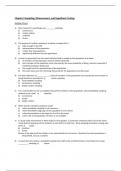
Test Bank for Research in Psychology, Methods and Design 8th Edition by Goodwin All Chapters
Test Bank for Research in Psychology, Methods and Design 8th Edition by Kerri Goodwin, James Goodwin Chapter 1. Scientific Thinking in Psychology Chapter 2. Ethics in Psychological Research Chapter 3. Developing Ideas for Research in Psychology Chapter 4. Sampling, Measurement, and Hypothesis Testing Chapter 5. Introduction to Experimental Research
- Package deal
- • 12 items •
- Chapter 4 Sampling, Measurement, and Hypothesis Testing • Exam (elaborations)
- Chapter 3 Developing Ideas for Research in Psychology • Exam (elaborations)
- Chapter 2 Ethics in Psychological Research • Exam (elaborations)
- Chapter 1 Scientific Thinking in Psychology • Exam (elaborations)
- Chapter 12 Small N Designs • Exam (elaborations)
- And more ….
Test Bank for Research in Psychology, Methods and Design 8th Edition by Kerri Goodwin, James Goodwin Chapter 1. Scientific Thinking in Psychology Chapter 2. Ethics in Psychological Research Chapter 3. Developing Ideas for Research in Psychology Chapter 4. Sampling, Measurement, and Hypothesis Testing Chapter 5. Introduction to Experimental Research
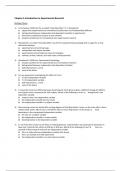
Chapter 5 Introduction to Experimental Research
Chapter 5 Introduction to Experimental Research 1) In his famous 1938 text, the so-called “Columbia bible,” R. S. Woodworth a) argued that experimental and correlational studies were not fundamentally different b) distinguished between independent and dependent variables in experiments c) dismissed correlational research as not scientific d) showed a preference for correlational over experimental research 2) Woodworth’s so-called “Columbia bible” was the first experimental psych...
- Package deal
- Exam (elaborations)
- • 15 pages •
Chapter 5 Introduction to Experimental Research 1) In his famous 1938 text, the so-called “Columbia bible,” R. S. Woodworth a) argued that experimental and correlational studies were not fundamentally different b) distinguished between independent and dependent variables in experiments c) dismissed correlational research as not scientific d) showed a preference for correlational over experimental research 2) Woodworth’s so-called “Columbia bible” was the first experimental psych...
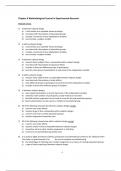
Chapter 6 Methodological Control in Experimental Research
1) A between-subjects design a) is also known as a repeated-measures design b) must deal with the problem of equivalent groups c) includes a minimum of two independent variables d) must include a subject variable 2) A within-subjects design a) is also known as a repeated-measures design b) must deal with the problem of equivalent groups c) includes a minimum of two independent variables d) must include a subject variable 3) A between-subjects design a) requires fewer subjects than a...
- Package deal
- Exam (elaborations)
- • 20 pages •
1) A between-subjects design a) is also known as a repeated-measures design b) must deal with the problem of equivalent groups c) includes a minimum of two independent variables d) must include a subject variable 2) A within-subjects design a) is also known as a repeated-measures design b) must deal with the problem of equivalent groups c) includes a minimum of two independent variables d) must include a subject variable 3) A between-subjects design a) requires fewer subjects than a...
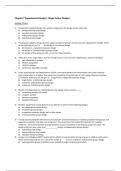
Chapter 7 Experimental Design I, Single‐Factor Designs
Chapter 7 Experimental Design I, Single‐Factor Designs Multiple Choice 1) If a between-subjects design uses random assignment, the design will be called a(n) a) nonequivalent groups design b) repeated-measures design c) independent groups design d) matched groups design 2) If a between-subjects design uses the subject variable of gender and has just one independent variable, which of the following is true? a) the design is a multilevel design b) the design is a repeated-measures des...
- Package deal
- Exam (elaborations)
- • 14 pages •
Chapter 7 Experimental Design I, Single‐Factor Designs Multiple Choice 1) If a between-subjects design uses random assignment, the design will be called a(n) a) nonequivalent groups design b) repeated-measures design c) independent groups design d) matched groups design 2) If a between-subjects design uses the subject variable of gender and has just one independent variable, which of the following is true? a) the design is a multilevel design b) the design is a repeated-measures des...
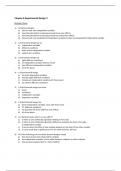
Chapter 8 Experimental Design II
Chapter 8 Experimental Design II 1) All factorial designs a) have at least two independent variables b) have the potential for producing at least three main effects c) have the potential for producing at least two interaction effects d) have at least one manipulated independent variable and one nonmanipulated independent variable 2) A 2x3 factorial design has six a) independent variables b) different conditions c) levels of the independent variable d) subjects per condition 3) A 2x4...
- Package deal
- Exam (elaborations)
- • 17 pages •
Chapter 8 Experimental Design II 1) All factorial designs a) have at least two independent variables b) have the potential for producing at least three main effects c) have the potential for producing at least two interaction effects d) have at least one manipulated independent variable and one nonmanipulated independent variable 2) A 2x3 factorial design has six a) independent variables b) different conditions c) levels of the independent variable d) subjects per condition 3) A 2x4...
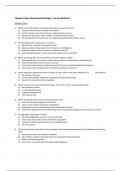
Chapter 9 Non‐Experimental Design I, Survey Methods
Multiple Choice 1) Which of the following is true about the history of survey research? a) surveys were not used until after World War I b) the first survey research was Kinsey’s pioneering sex surveys c) Darwin and his cousin, Francis Galton, created the first surveys d) the method of the “questionary” was vigorously promoted by William James 2) Hall developed the “questionary” in order to a) discover the “contents of children’s minds” b) disprove Galton’s ideas abou...
- Package deal
- Exam (elaborations)
- • 17 pages •
Multiple Choice 1) Which of the following is true about the history of survey research? a) surveys were not used until after World War I b) the first survey research was Kinsey’s pioneering sex surveys c) Darwin and his cousin, Francis Galton, created the first surveys d) the method of the “questionary” was vigorously promoted by William James 2) Hall developed the “questionary” in order to a) discover the “contents of children’s minds” b) disprove Galton’s ideas abou...
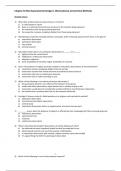
Chapter 10 Non‐Experimental Design II, Observational and Archival Methods
Chapter 10 Non‐Experimental Design II, Observational and Archival Methods 1) What does all observational research have in common? a) it is descriptive in nature b) there is no attempt to provide any structure to the situation being observed c) the researcher joins the group being observed d) the researcher remains completely hidden from those being observed 2) Attempting to study the everyday behaviors of people, while remaining separate from them, is the goal of a) naturalistic observ...
- Package deal
- Exam (elaborations)
- • 8 pages •
Chapter 10 Non‐Experimental Design II, Observational and Archival Methods 1) What does all observational research have in common? a) it is descriptive in nature b) there is no attempt to provide any structure to the situation being observed c) the researcher joins the group being observed d) the researcher remains completely hidden from those being observed 2) Attempting to study the everyday behaviors of people, while remaining separate from them, is the goal of a) naturalistic observ...
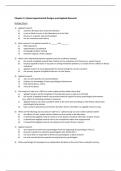
Chapter 11 Quasi‐Experimental Designs and Applied Research
Chapter 11 Quasi‐Experimental Designs and Applied Research 1) Applied research a) examines the basic laws of human behavior b) is just as likely to occur in the laboratory as in the field c) focuses on a specific real world problem d) has no connection with theory 2) Basic research is to applied research as ______ is to _______. a) field; laboratory b) experimental; correlational c) knowledge; problem solving d) between-subjects; within-subjects 3) What is the relationship betwe...
- Package deal
- Exam (elaborations)
- • 16 pages •
Chapter 11 Quasi‐Experimental Designs and Applied Research 1) Applied research a) examines the basic laws of human behavior b) is just as likely to occur in the laboratory as in the field c) focuses on a specific real world problem d) has no connection with theory 2) Basic research is to applied research as ______ is to _______. a) field; laboratory b) experimental; correlational c) knowledge; problem solving d) between-subjects; within-subjects 3) What is the relationship betwe...
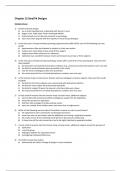
Chapter 12 Small N Designs
Chapter 12 Small N Designs 1) Small N research designs a) are a recent development, originating with Skinner’s work b) began in the 1930s when Fisher developed ANOVA c) characterized most of the early research in psychology d) have never been popular with the majority of research psychologists 2) In the early years of experimental psychology (approximately ), each of the following was true except a) experimenters often participated as subjects in their own studies b) studies were mo...
- Package deal
- Exam (elaborations)
- • 13 pages •
Chapter 12 Small N Designs 1) Small N research designs a) are a recent development, originating with Skinner’s work b) began in the 1930s when Fisher developed ANOVA c) characterized most of the early research in psychology d) have never been popular with the majority of research psychologists 2) In the early years of experimental psychology (approximately ), each of the following was true except a) experimenters often participated as subjects in their own studies b) studies were mo...
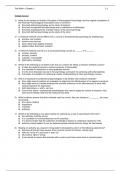
Chapter 1 Scientific Thinking in Psychology
1) What do the preface to Wundt’s Principles of Physiological Psychology and the original constitution of the American Psychological Association have in common? a) they both defined psychology as the study of behavior b) they both recognized that psychology was a subdivision of philosophy c) they both emphasized the scientific nature of the new psychology d) they both defined psychology as the study of the mind 2) A research methods course differs from a course in developmental psycholog...
- Package deal
- Exam (elaborations)
- • 12 pages •
1) What do the preface to Wundt’s Principles of Physiological Psychology and the original constitution of the American Psychological Association have in common? a) they both defined psychology as the study of behavior b) they both recognized that psychology was a subdivision of philosophy c) they both emphasized the scientific nature of the new psychology d) they both defined psychology as the study of the mind 2) A research methods course differs from a course in developmental psycholog...

Chapter 7 Life-Span Development of the Brain and Behavior
Chapter 4 The Chemistry of Behavior Neurotransmitters and Neuropharmacology
Chapter 5 Hormones and the Brain
Test Bank for Myers' Psychology for the AP® Course Third Edition David G. Myers; C. Nathan DeWall (All Chapters)
Chapter 4 The Chemistry of Behavior Neurotransmitters and Neuropharmacology